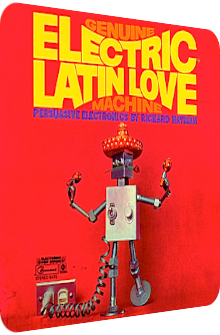
Richard Hayman
Genuine Electric
Latin Love Machine
1969
It is a pity that there are so many Moog albums out there, for the real diamonds do not shine and glow as iridescently as they could if they showed insular, one-of-a-kind soundscapes. However, it is always a good thing marketing-wise to present fans what they want, to give in and release more of the same in order to, you know the story, cash in and make a living. These sentences could mirror the presumptions and raised brows of Exotica fans who have heard of – or even encountered – the various Moog albums of their favorite Jazz quartets. Unsurprisingly, harmonica luminary, composer and arranger Richard Hayman (born 1920) has given in to the Moog craze of the late 60’s where the artificial textures of that synthesizer opened the door to a magnanimous wealth of surfaces where no theremin or ondioline has ventured before. At least the eleven concoctions – two of them by Hayman, three of them exotic – in tandem with the fabulous album title should amplify the awareness and kudos in terms of Hayman’s effort.
Released in 1969 on Enoch Light’s Command Records, it is best to read the album title aloud (is nobody looking?): Genuine Electric Latin Love Machine. Wow! Okay, there is that signal term called Latin thrown in, but there is in fact nothing particularly Latin about this album despite a few maracas. The Moog synthesizer is in the center of the universe, and the discordant and harmonious frequencies are few and far between. However, the Moog experiment can be deemed successful regardless, as the harmonica player and arranger takes the material from the right sources. This is no late 60’s album that reworks the popular Rock songs of that decade, but a varied yet cohesive capsule of buzzzzzz.
Given the radical nature (or departure) of this album that is so unlike anything Richard Hayman has produced, recorded and composed heretofore, the poetic title of the opener suddenly carries a whole new connotation: The Windmills Of Your Mind by Alan & Marilyn Bergman and Michel Legrand graces the Thomas Crown Affair, but here said mind is not just affected by windmills, but longitudinal landspouts. Clocking in at over six minutes, Hayman’s interpretation sits somewhere between a Gothic cesspool and a pre-cyberspace wasteland, with the transcendental repetition of the solar winds blowing over the harpsichordic Moog setting. Sizzling splinters, bubbling Hammond whirlwinds and electric guitars are on board alright, but two things are particularly noteworthy: a surprisingly dirty drum kit akin to the – back then nonexistent – Hip Hop raucousness and the harmonica signature which adds an earthen rurality to the turmoil. Mightily alienating back in 1969, still a turmoil to this day.
The Exotica fan might shrug his shoulders, but not in the wake of the next two tunes, Ernesto Lecuona’s La Comparsa and Moisés Simóns’ The Peanut Vendor; while the former unites arpeggiated sun-kissed synthetics of Capri with bouncing dark matter pads, the latter worships reverberated cylon metallics and springy coils with heftily shaken maracas, smoking hot Hammond organs and an increasingly robotic wonkiness. Burt Bacharach’s and Hal David’s The Look Of Love receives a mellower treatment comprised of car horn eulogies, sparkling Moog crystals and lactate bumble bee streamlets, with Hare Krishna by Galt McDermot, Gerome Ragni and James Rado ending side A with heterodyned cacophonies, sine flutes and zoetropic laser pulses. This one is audaciously dissonant, oh my!
Side B is no less riotous, a wild ride is waiting. Teddy Randazzo’s and Bob Weinstein’s Goin’ Out Of My Head is yet again fittingly transmuted into a six and a half minutes long psychedelic panopticon of trapped sitar-esque guitars, swooshing dust busters and aerose flute rhizomes. It is the lava glissando of the Hammond organ however which truly enchants in this effect-driven yet mostly euphonious diorama, adding both a seething column and sane anchor to the arrangement. Richard Hayman’s own Dansero follows, a superb bit of artificial tropicana augmented via liquedous blips, swimming pool afterglows and leisure suit Moog fibers. Like the soundtrack to a posh hotel as illumined by the great ball in the sky, you better absorb its insouciance… or else. And this "else" comes in the shape of Antonio Carlos Jobim’s classic The Girl From Ipanema, presented here with lascivious whistles, Wanderley-esque organ backdrops, theremin-inspired Moog tones and an otherwise gorgeously plastic jungle scenery complete with a femme fatale as a backing vocalist plus warmhearted guitar chords. In all seriousness a great transformation!
Hayman comes up with a second composition of his own, the carnivalesque Samba De Victoria with fusillades of shakers, asbestus-coated rhythmic burps and sinister harpsichord blisters. The drums and maracas are the only good thing, as this lady is more of a scapegrace than a coquette. The curious Melody #2 follows, created by an otherwise mystical R.E. Danzig – a moniker? Whatever may be the case, said Melody #2 knows to bewitch with blue doldrums and melancholic tone sequences that gyre between a witches’ house and a Teutonic forest. Maybe the listener has already adjusted to the tohubohu, but I feel that this is yet another streamlined effort… in the given context, of course. Bert Kaempfert’s Spanish Eyes closes the album, loaded with rotatory fake marimba blobs, a rhythm in 3/4 time and gnarly barrel organ mirages.
Even in hindsight, it is crystal clear what the fuzz in terms of this album is all about. A title as vivid and bold as Genuine Electric Latin Love Machine better worships a histrionic concupiscence, relies on antipodes as well as antidotes and genuflects before the gigantomachy that is called Moog versus the world. It is not necessary to hail the crap out of Richard Hayman’s album, this is neither the time nor the place. Besides, Exotica fans will distill much more value and fun out of Voodoo! (1959) and possibly Havana In Hi-Fi (1957), two of Hayman’s glorious string-infested albums. And yet there is something wonderful about Genuine Electric Latin Love Machine, and no, it is not necessarily the Moog organ in the epicenter.
It is true that once the listener grows tired of the Moog craze of yesteryear, there is absolutely no need for him or her to check out this opalescent gem. But there is majesty found in them sparklers: the much more conventional and convenient Hammond organ revs up the apocryphal antra with its ebullient warmth, a few harmonica tidbits make the bystander ponder the source – i.e. whether it is really a harmonica or a cleverly tweaked Moog preset – and last but not least, the real-world percussion sp(l)ices the bleepy and farting keyboard prongs. Even though the effects, swooshes and stereo effects become a tad gaudy, it is the melodies which know to enthrall. Even in this malfunctioning state, the classics breathe and exude verve. If you favor Moog albums, Richard Hayman’s Genuine Electric Latin Love Machine is a no-brainer and strong album overall, an artifact of an exciting time. It is, alas, no Exotica album as played by a quartet, but Space-Age fans shall triple-check its glaring red complexion. Available on vinyl and digitally.
Exotica Review 390: Richard Hayman – Genuine Electric Latin Love Machine (1969). Originally published on Nov. 15, 2014 at AmbientExotica.com.
